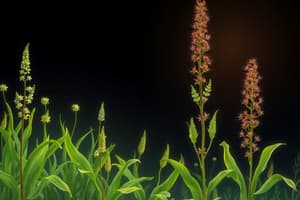Podcast
Questions and Answers
What is a primary characteristic of monocot plants?
What is a primary characteristic of monocot plants?
- One cotyledon per seed (correct)
- Vascular cambium present
- Two cotyledons per seed
- Net leaf venation
Dicot plants have flower parts that typically occur in units of five or four.
Dicot plants have flower parts that typically occur in units of five or four.
True (A)
What is the family name for wheat?
What is the family name for wheat?
Poaceae
The genus name for peas is ______.
The genus name for peas is ______.
Which of the following is NOT a characteristic of dicot plants?
Which of the following is NOT a characteristic of dicot plants?
Match the plant types with their characteristics:
Match the plant types with their characteristics:
What is the significance of vascular cambium in dicot plants?
What is the significance of vascular cambium in dicot plants?
Cereal grains belong to the ______ family.
Cereal grains belong to the ______ family.
What is the correct pronunciation of the plant family name 'Poaceae'?
What is the correct pronunciation of the plant family name 'Poaceae'?
The radicle is the first structure to emerge from almost any germinating seed.
The radicle is the first structure to emerge from almost any germinating seed.
Name the three distinct parts of a cereal grain embryo.
Name the three distinct parts of a cereal grain embryo.
The ____ root system is formed from the radicle and lateral seminal roots.
The ____ root system is formed from the radicle and lateral seminal roots.
Match the following parts of the cereal grain embryo with their functions:
Match the following parts of the cereal grain embryo with their functions:
What is the role of the coleorhiza?
What is the role of the coleorhiza?
The secondary adventitious root system develops from the coleoptilar node below the seminal root system.
The secondary adventitious root system develops from the coleoptilar node below the seminal root system.
What is the shoot apical meristem (SAM)?
What is the shoot apical meristem (SAM)?
What is the main difference in the number of cotyledons between monocotyledonous and dicotyledonous plants?
What is the main difference in the number of cotyledons between monocotyledonous and dicotyledonous plants?
A monocotyledon embryo contains two cotyledons.
A monocotyledon embryo contains two cotyledons.
Name two types of germination in dicotyledonous plants.
Name two types of germination in dicotyledonous plants.
The part of the seed that absorbs nutrients during germination in monocots is called the ______.
The part of the seed that absorbs nutrients during germination in monocots is called the ______.
Which of the following describes a trait of dicotyledonous plants?
Which of the following describes a trait of dicotyledonous plants?
Match the following parts of a seed with their respective functions:
Match the following parts of a seed with their respective functions:
Dicotyledon seeds always exhibit hypogeal germination.
Dicotyledon seeds always exhibit hypogeal germination.
Monocotyledons include plants from the family ______.
Monocotyledons include plants from the family ______.
What primarily composes the bran of a cereal grain?
What primarily composes the bran of a cereal grain?
Cereal grains are considered fruits because their structure is derived from the ovary wall.
Cereal grains are considered fruits because their structure is derived from the ovary wall.
What is the function of the aleurone layer in cereal grains?
What is the function of the aleurone layer in cereal grains?
The protective outer covering of a seed is called the ______.
The protective outer covering of a seed is called the ______.
Match the following parts of a dicot embryo with their functions:
Match the following parts of a dicot embryo with their functions:
Which of the following crops is NOT an oilseed crop grown in Saskatchewan?
Which of the following crops is NOT an oilseed crop grown in Saskatchewan?
The germ of a cereal grain consists entirely of the endosperm.
The germ of a cereal grain consists entirely of the endosperm.
What are the two main classifications of plants whose seeds always contain two cotyledons?
What are the two main classifications of plants whose seeds always contain two cotyledons?
What does the term 'hypogeal' refer to in germination?
What does the term 'hypogeal' refer to in germination?
In epigeal germination, the cotyledons remain below the soil surface.
In epigeal germination, the cotyledons remain below the soil surface.
What role do cotyledons play during epigeal germination?
What role do cotyledons play during epigeal germination?
In hypogeal germination, the epicotyl is protected from soil abrasion by bending over to draw the ______ through the soil.
In hypogeal germination, the epicotyl is protected from soil abrasion by bending over to draw the ______ through the soil.
Match the following terms with their definitions:
Match the following terms with their definitions:
What is the main function of the cotyledons in dicot seeds?
What is the main function of the cotyledons in dicot seeds?
The hilum is a visible scar on the testa where the seed was attached inside the fruit.
The hilum is a visible scar on the testa where the seed was attached inside the fruit.
What is the first organ to emerge during germination?
What is the first organ to emerge during germination?
In hypogeal germination, the cotyledons remain ______ the soil surface.
In hypogeal germination, the cotyledons remain ______ the soil surface.
Which of the following types of germination is characteristic of all cereal crops?
Which of the following types of germination is characteristic of all cereal crops?
Secondary adventitious roots develop from the ______ node.
Secondary adventitious roots develop from the ______ node.
Epigeal germination results in cotyledons remaining below the soil surface after germination.
Epigeal germination results in cotyledons remaining below the soil surface after germination.
Flashcards
Monocots
Monocots
A group of plants with one embryonic leaf (cotyledon) in the seed.
Dicots
Dicots
A group of plants with two embryonic leaves (cotyledons) in the seed.
Cotyledon
Cotyledon
An embryonic leaf that is often swollen with nutrients to nourish the seed.
Scutellum
Scutellum
Signup and view all the flashcards
Endosperm
Endosperm
Signup and view all the flashcards
Embryo
Embryo
Signup and view all the flashcards
Poaceae
Poaceae
Signup and view all the flashcards
Germination
Germination
Signup and view all the flashcards
Monocot Plants
Monocot Plants
Signup and view all the flashcards
Dicot Plants
Dicot Plants
Signup and view all the flashcards
Parallel Leaf Venation
Parallel Leaf Venation
Signup and view all the flashcards
Net/Branched Leaf Venation
Net/Branched Leaf Venation
Signup and view all the flashcards
Vascular Cambium
Vascular Cambium
Signup and view all the flashcards
Cereal Grain
Cereal Grain
Signup and view all the flashcards
Poaceae pronunciation
Poaceae pronunciation
Signup and view all the flashcards
Monocot embryo parts
Monocot embryo parts
Signup and view all the flashcards
Radicle
Radicle
Signup and view all the flashcards
Coleorhiza
Coleorhiza
Signup and view all the flashcards
Seminal root system
Seminal root system
Signup and view all the flashcards
Plumule
Plumule
Signup and view all the flashcards
Shoot apical meristem (SAM)
Shoot apical meristem (SAM)
Signup and view all the flashcards
Secondary adventitious root system
Secondary adventitious root system
Signup and view all the flashcards
Cereal Grain Pericarp
Cereal Grain Pericarp
Signup and view all the flashcards
Aleurone Layer
Aleurone Layer
Signup and view all the flashcards
Seed Testa
Seed Testa
Signup and view all the flashcards
Dicot Embryo Parts
Dicot Embryo Parts
Signup and view all the flashcards
Bran (Cereal Grain)
Bran (Cereal Grain)
Signup and view all the flashcards
Dicot seed endosperm
Dicot seed endosperm
Signup and view all the flashcards
Hilum
Hilum
Signup and view all the flashcards
Micropyle
Micropyle
Signup and view all the flashcards
Hypogeal germination
Hypogeal germination
Signup and view all the flashcards
Epigeal germination
Epigeal germination
Signup and view all the flashcards
Epicotyl
Epicotyl
Signup and view all the flashcards
Hypocotyl
Hypocotyl
Signup and view all the flashcards
Study Notes
Crop Emergence & Development
- Learning Objectives: Distinguish between monocot and dicot embryos; describe differences between monocots and dicots; list and describe two dicot germination types; identify two monocot internode elongation types.
Key Terms & Concepts
- aleurone layer: Protein-rich layer surrounding endosperm
- bran: Outermost layer of a cereal grain, consisting of pericarp, testa, and aleurone layer.
- bran: The outer covering of a seed
- caryopsis: A type of fruit, specifically the fruit of a grass
- coleoptilar node: Node at the base of the coleoptile
- coleoptile: Protective sheath around the plumule
- coleorhiza: Protective sheath around the radicle
- cotyledon: Seed leaf
- dicot: Plant with two cotyledons
- embryo: Young plant within the seed
- embryonic axis: The central column of the embryo in a seed
- endosperm: Food-storage tissue in the seed
- epicotyl: Part of the embryonic axis above cotyledons
- epigeal germination: Seedling with cotyledons above ground
- fruit: Ripened ovary of a flower
- germ: Embryo of a seed
- grain: Mature seed of a cereal plant
- hilum: Scar on the seed where it was attached to the fruit
- hull: Outer covering of the seed
- hypocotyl: Part of the embryonic axis below cotyledons
- hypogeal germination: Seedling with cotyledons below ground
- mesocotyl: Stem between coleoptile and the radicle
- micropyle: Small opening in the seed coat
- monocotyledon: Seed with one cotyledon
- pericarp: Ovary wall, forming a part of the fruit
- plumule: Embryonic shoot
- Poaceae: Grass family
- radicle: Embryonic root
- scutellum: Specialized cotyledon in monocots, used for absorbing endosperm
- seminal root system: Roots arising from the radicle
- secondary adventitious root system: Roots arising from the coleoptilar node
- shoot apical meristem (SAM): Growth point of the shoot
- sub-crown internode: Underground stem in some grasses
- testa: Seed coat
- testa: The outer layer of a seed
Introduction to Monocots and Dicots
- Monocots (e.g., wheat) and dicots (e.g., peas) are major plant classifications.
- The primary distinguishing feature is the number of cotyledons in the seed
- Monocots have one cotyledon; dicots have two.
- Cotyledons are embryonic structures that provide nourishment during germination.
Monocot (Cereal) Embryo
- Cereal embryos consist of radicle, plumule, and scutellum (cotyledon).
- The radicle develops into the root system.
- The plumule develops into the shoot system.
- The scutellum absorbs nutrients from the endosperm.
Dicots (Oilseeds and Pulses)
- Dicots have two cotyledons.
- Cotyledons play a crucial role in storing food for the developing seedling, absorbing nutrients from the endosperm.
Germination and Emergence
- Germination involves seedling development.
- Hypogeal germination: Cotyledons remain below the soil surface.
- Epigeal germination: Cotyledons are lifted above the soil surface.
Studying That Suits You
Use AI to generate personalized quizzes and flashcards to suit your learning preferences.




